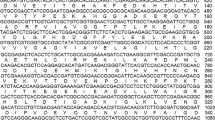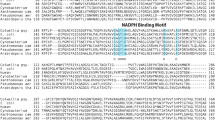Abstract
Thioredoxin (Trx) is a highly conserved and multi-functional protein that plays a pivotal role in maintaining the redox state of the cell and in protecting the cell against oxidative stress. Trx gene from Antarctic sea-ice bacteria Pseudoalteromonas sp. AN178 was cloned and expressed as soluble protein in Escherichia coli (designated as PsTrx). Trx gene consisted of an open reading frame of 324-bp nucleotides encoding a protein of 108 amino acids with a calculated molecular mass of 11.88 kDa. The deduced protein included the conserved Cys–Gly–Pro–Cys active-site sequence. After purification by a single step Ni–NTA affinity chromatography, recombinant PsTrx with a high specific activity of 96.67 U/mg was obtained. The purified PsTrx had an optimal temperature and pH of 25 °C and 7.0, respectively, and showed about 55 % of the residual catalytic activity even at 0–10 °C. It had high tolerance to a wide range of NaCl concentrations (0–2 M NaCl) and was stable in the presence of H2O2. This research suggested that PsTrx displayed unique catalytic properties.




Similar content being viewed by others
References
Russell NJ (1997) Psychrophilic bacteria-molecular adaptations of membrane lipids. Comp Biochem Physiol 118:489–493
Chattopadhyay MK, Raghu G, Sharma YV et al (2011) Increase in oxidative stress at low temperature in an antarctic bacterium. Curr Microbiol 62:544–546
Gocheva YG, Tosi S, Krumova ET et al (2009) Temperature downshift induces antioxidant response in fungi isolated from Antarctica. Extremophiles 13:273–281
Regoli F, Nigro M, Chiantore M et al (2002) Seasonal variations of susceptibility to oxidative stress in Adamussium colbecki, a key bioindicator species for the Antarctic marine environment. Sci Total Environ 289:205–211
Koháryová M, Kolárová M (2008) Oxidative stress and thioredoxin system. Gen Physiol Biophys 27:71–84
Zeller T, Klug G (2006) Thioredoxins in bacteria: functions in oxidative stress response and regulation of thioredoxin genes. Naturwissenschaften 93:259–266
Holmgren A (1985) Thioredoxin. Annu Rev Biochem 54:237–271
Arnér ES, Holmgren A (2000) Physiological functions of thioredoxin and thioredoxin reductase. Eur J Biochem 267:6102–6109
Laurent TC, Moore EC, Reichard P (1964) Enzymatic synthesis of deoxyribonucleotides. IV. Isolation and characterization of thioredoxin, the hydrogen donor from Escherichia coli B. J Biol Chem 239:3436–3444
Miranda-Vizuete A, Damdimopoulos AE, Gustafsson J et al (1997) Cloning, expression, and characterization of a novel Escherichia coli thioredoxin. J Biol Chem 272:30841–30847
Tanaka R, Kosugi K, Mizukami M et al (2004) Expression and purification of thioredoxin (TrxA) and thioredoxin reductase (TrxB) from Brevibacillus choshinensis. Protein Expr Purif 37:385–391
Thön M, Al-Abdallah Q, Hortschansky P et al (2007) The thioredoxin system of the filamentous fungus Aspergillus nidulans: impact on development and oxidative stress response. J Biol Chem 282:27259–27269
Ying SH, Wang XH, Feng MG (2010) Characterization of a thioredoxin (BbTrx) from the entomopathogenic fungus Beauveria bassiana and its expression in response to thermal stress. Can J Microbiol 56:934–942
Grimaldi P, Ruocco MR, Lanzotti MA et al (2008) Characterisation of the components of the thioredoxin system in the archaeon Sulfolobus solfataricus. Extremophiles 12:553–562
Sambrook J, Russell DW (2001) Molecular cloning: a laboratory manual, 3rd edn. Cold Spring Harbor Laboratory Press, Cold Spring Harbor, New York
Holmgren A (1979) Thioredoxin catalyzes the reduction of insulin disulfides by dithiothreitol and dihydrolipoamide. J Biol Chem 254:9627–9632
Prongay AJ, Engelke DR, Williams CH (1989) Characterization of two active site mutations of thioredoxin reductase from Escherichia coli. J Biol Chem 264:2656–2664
Martin JL (1995) Thioredoxin-a fold for all reasons. Structure 3:245–250
Ben Bacha AG, Mejdoub H (2012) Purification and biochemical characterization of an organic-solvent-tolerant thioredoxin from Dromedary Pancreas. Protein J 31:1–7
Herrmann EC, Moore EC (1973) Purification of thioredoxin from rat Novikoff ascites hepatoma. J Biol Chem 248:1219–1223
Gelhaye E, Rouhier N, Navrot N et al (2005) The plant thioredoxin system. CMLS Cell Mol Life Sci 62:24–35
Montrichard F, Alkhalfioui F, Yano H et al (2009) Thioredoxin targets in plants: the first 30 years. J Proteomics 72:452–474
Wang QF, Hou YH, Xu Z et al (2008) Purification and properties of an extracellular cold-active protease from the psychrophilic bacterium Pseudoalteromonas sp. NJ276. Biochem Eng J 38:362–368
Wang QF, Hou YH, Ding Y et al (2012) Purification and biochemical characterization of a cold-active lipase from Antarctic sea ice bacteria Pseudoalteromonas sp. NJ 70. Mol Biol Rep 39:9233–9238
Spector A, Yan GZ, Huang RR et al (1988) The effect of H2O2 upon thioredoxin-enriched lens epithelial cells. J Biol Chem 263:4984–4990
Acknowledgments
This study was supported by National Natural Science Foundation of China (31100037), the Natural Science Foundation of Shandong Province (ZR2009DQ023, ZR2011CM003), and Natural Scientific Research Innovation Foundation in Harbin Institute of Technology (HIT-NSRIF201011).
Author information
Authors and Affiliations
Corresponding author
Rights and permissions
About this article
Cite this article
Wang, Q., Hou, Y., Qu, J. et al. Molecular cloning, expression, purification and characterization of thioredoxin from Antarctic sea-ice bacteria Pseudoalteromonas sp. AN178. Mol Biol Rep 40, 6587–6591 (2013). https://doi.org/10.1007/s11033-013-2771-4
Received:
Accepted:
Published:
Issue Date:
DOI: https://doi.org/10.1007/s11033-013-2771-4




